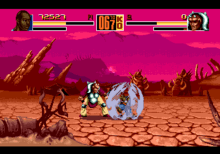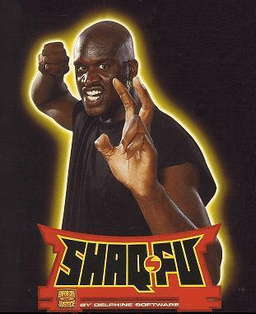Shaq Fu
| Shaq Fu | |
|---|---|
|
Packaging for the Genesis version. | |
| Developer(s) |
Delphine Software International (Mega Drive/Genesis, SNES) Tiertex Design Studios (Game Gear) Unexpected Development (Game Boy) The Dome Software Developments (Amiga) |
| Publisher(s) |
Electronic Arts (Mega Drive/Genesis, U.S. SNES, Game Gear) Black Pearl Software (Game Boy) Ocean Software (EU SNES, Amiga) |
| Designer(s) | Paul Cuisset |
| Composer(s) | Raphaël Gesqua |
| Engine | Proprietary |
| Platform(s) | Genesis, Super NES, Game Gear, Game Boy, Amiga |
| Release date(s) |
Mega Drive/Genesis SNES Game Gear
Game Boy
Amiga
|
| Genre(s) | Fighting |
| Mode(s) | Single-player, two-player simultaneous, Tournament mode |
Shaq Fu is a 2D fighting game initially released for the Genesis and Super NES on October 28, 1994. It was ported to the Game Gear, Game Boy, and Amiga platforms in 1995. The game was published by Electronic Arts and developed by the now-defunct Delphine Software International. It features former professional basketball player Shaquille O'Neal (also known as Shaq) as a playable character. Shaq Fu was met with mixed responses from critics upon release, though it has since come to be considered one of the worst video games of all time. A sequel, Shaq Fu: A Legend Reborn, is in development.[1]
Story
In the game's storyline, Shaquille O'Neal walks into a dojo while heading to a charity basketball game in Tokyo, Japan. After speaking with Leotsu, a martial arts master, Shaq goes to another dimension, the Second World, where he must rescue a young boy named Nezu from the evil mummy Sett Ra.
Variations

The Genesis version of Shaq Fu has five more playable characters (Auroch, Colonel, Diesel, Leotsu, and Nezu) and three more stages (The Lab, The Wasteland, and Yasko Mines) than the Super NES version, thus the Genesis version has a longer story mode. The North Gate/South Gate stage is accessible in the SNES version with a cheat code, whereas the Genesis version has the North Gate/South Gate stage available by default. The Amiga version contains the same content as the Genesis version (it keeps the text "Licensed by Sega Enterprises, LTD" leftover from that version on the title screen), though the backgrounds have no animation. It also only has three tunes; there is no background music during the fights.
The Game Boy version has the same seven characters as the Super NES version, whereas the Game Gear version only has six characters (Shaq, Leotsu, Mephis, Rajah, Kaori, and Sett Ra). Both the Game Boy and Game Gear versions lack a tournament mode and in-game voices. Due to the Game Boy's monochrome screen, the Game Boy version is not in color.
Both the Genesis and SNES versions of the game contained a hidden button sequence that would initiate a "blood code" in the spirit of Mortal Kombat. The blood effects were subdued and minor which kept the game at its "MA-13" (known by modern rating standard as "T") rating. However, the blood code gave access to finishing moves within the game that were triggered by striking the opponent in a certain way to end the match. The finishing moves were not gory as those depicted in the fatalities of Mortal Kombat, but were considerably more violent when performed against monster-type characters in the game, rather than humans. Some of the finishing moves that have been discovered include the following examples:
- Sett Ra, when struck with a high attack toward his head, would drop to his knees as his head caught fire. The body of Sett Ra would then dissolve, the wraps falling to the ground and the smoldering shoulder armor tumbling forward.
- Beast, when struck in a certain way, would have his skin dissolve away revealing a skeleton which crumbles to the ground.
- Mephis, when struck with a mid-range attack, would shatter into ghost-like shards which fade away into the air, leaving his decrepit robe behind.
- Voodoo, when struck in a certain way, would fade into smoke, leaving her clothing behind on the ground.
- Genesis-exclusive character Auroch would turn to stone and explode if struck with a mid-range attack.
Reception
Shaq Fu received mixed reviews at the time of its release. GamePro gave the SNES version a positive review, saying that the unusually small size of the sprites is balanced off by the incredibly fast game speed. They also praised the "ultra sharp" controls and impressive digitized graphics.[2] They reviewed the Genesis version as superior to the SNES version due to its additional characters and improved controls, and concluded that the game is "fun once you get used to the small, fast sprites."[3] Next Generation Magazine gave the game a 2/5. One of the multiple reviewers at Electronic Gaming Monthly scored it as a 6/10, and another gave it a 4/10.[4] It received a grade of D from Entertainment Weekly.[5]
Retrospective criticism of the game has been generally negative. GameTrailers rated it number 4 Worst in their "Top Ten Best and Worst Video Games".[6] Allgame gave it a negative review, commenting that "Shaq Fu is a dud" in terms of fighting games based on basketball players.[7] Game Informer magazine placed it number 2 on the Top 10 Fighting Games We'd Like To Forget. In response to the negative feedback to the game, Levi Buchanan from IGN stated it was undeserved as a result of collective exaggerations.[8] In the September 1997, Nintendo Power had 12 staff members vote in a list for the top 100 games of all time.[9] This list also included a 10 worst games of all-time list voted by the staff, which placed Shaq Fu at 3rd worst place on their list.[10] The article stated that it was "not possible to come up with a worse idea than this."[10]
The website shaqfu.com is dedicated to "liberating [the game] from existence" by finding and destroying as many copies of the game as possible.
Sequel
At the 2014 Consumer Electronics Show, Shaquille O’Neal confirmed speculations in an interview with GamerFitnation that there would be a Shaq Fu 2.[11] On March 6, 2014 an Indiegogo crowdfunding campaign was started for Shaq-Fu: A Legend Reborn. It will feature gameplay that heavily differs from its predecessor, more akin to a beat 'em up. The funding goal was $450,000 USD. If achieved, the game creators at Big Deez Productions promised that the game would be released for consoles (PC, PlayStation 4, Xbox One, Wii U, PlayStation 3, and Xbox 360). The campaign ended on May 5, 2014, with the funding goal exceeded at $473,884.[1] The game creators at Big Deez announced they will be accepting Quark crypto-currency as a method of in-game payment.[12]
See also
References
- 1 2 Indiegogo - Shaq-Fu: A Legend Reborn
- ↑ "ProReview: Shaq Fu". GamePro (64). IDG. November 1994. p. 124.
- ↑ "ProReview: Shaq Fu". GamePro (65). IDG. December 1994. p. 98.
- ↑ Lachel, Cyril (17 August 2013). "Shaq Fu: What Did Critics Think at the Time?". Defunct Games. Retrieved 17 February 2014.
- ↑ Strauss, Bob (16 December 1994). "Shaq-Fu". Weekly Inc. Retrieved 17 February 2014.
- ↑ Top Ten Best and Worst Games of All Time, GameTrailers.com.
- ↑ Weiss, Brett Alan. "Shaq Fu Review". Allgame. Retrieved October 8, 2011.
- ↑ Buchanan, Levi (October 20, 2008). "In Defense of Shaq Fu". IGN. Retrieved October 8, 2011.
- ↑ "100 Best Games of All Time". Nintendo Power. Vol. 100. September 1997. p. 88.
- 1 2 "100 Best Games of All Time". Nintendo Power. Vol. 100. September 1997. p. 97.
- ↑ Bridge, Zachary. "CES 2014: Shaq Confirms Shaq Fu 2 "Coming Soon" #ShaqFu2". GamerFitnation. GamerFitnation. Retrieved 14 January 2014.
- ↑ Tran, Calvin. "QuarkCoin Partners with ShaqFu 2 Team". CryptoCoins News. CryptoCoinsNews. Retrieved 12 April 2014.
External links
- Shaq Fu at MobyGames
- Anti-Shaq Fu website
- Save Shaq Fu
- The Sega Genesis version of Shaq Fu can be played for free in the browser at the Internet Archive
